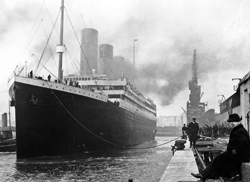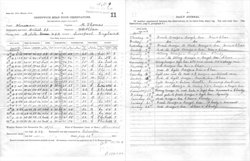
|

Click images for more details
|
|
Contact: Scott Woodruff
|
PSL Contributes to Titanic Book/Documentary
April 5, 2012
A documentary about the sinking of the Titanic and based on Tim Maltin's new book A Very Deceiving Night, will air this month – premiering April 5th on the Smithsonian Channel and appearing later on the National Geographic International Channel. The documentary, entitled Titanic: Mystery Solved, follows Maltin's research from an investigation into why a nearby ship did not come to the Titanic's rescue into a new theory explaining why it actually hit an iceberg. Scott Woodruff of ESRL's Physical Sciences Laboratory (PSL), and Eric Freeman of NOAA's National Climatic Data Center (NCDC), among others at NOAA and internationally, helped facilitate some of Maltin's research and were interviewed on camera for this piece.
Maltin contacted Woodruff, who has worked since 1981—in partnership with NCDC and the National Center for Atmospheric Research (NCAR)—on the International Comprehensive Ocean-Atmosphere Data Set (ICOADS). That project compiles, quality controls, and makes publicly accessible worldwide marine meteorological observations—presently extending from 1662 to date—from ships, buoys, and other in situ observing platforms. Woodruff provided Maltin with background information including how ship observations were gradually standardized since the landmark international 1853 Maritime Conference in Brussels, and how in the 1950s/60s data from ships' reports were digitized onto computer punched cards. But because of the limits of that technology, not all reported information could be captured; thus as Woodruff helped Maltin interpret ICOADS data, it became apparent that in this case not only the meteorological measurements were needed, but also remarks entered on the original records. Woodruff referred Maltin to NCDC where, with Eric Freeman's help, he was ultimately able to access copies of original records in the NCDC archive. Maltin's search also led him to the UK's Met Office and Germany's DWD among other places.
ICOADS data and products have been extensively used for climate research around the world. This includes efforts to reanalyze past conditions, which will help researchers to understand causes of previous 'climate catastrophes' and improve future predictions. Maltin's book and the resulting video are yet other examples of how this important historical information can be utilized to explore mysteries of the past.